This is what I usually make when making music videos, where I film performers or bands, miming to playback, being filmed by (usually) multiple cameras over multiple takes. The ambition for music videos based around performance is that you try to compensate for not being in a audience for a live performance. You strive to do this through using multiple camera angles, distances and regular cutting between those angles, distances to move in and around the performer, or band, as they perform – and feel the kind of involvement you might feel as if you had been in a live performance. In a sense, you are trading the immediacy of a live performance with the intimacy and involvement of a filmed music video. The viewer isn’t there – but they do get to be involved with performance of the song.
These are typical of the performance-based music videos I make:
|
Elizabeth Cornish “The End” (Studio filmed) |
Free Control “Strawman” (Studio filmed) |
A majority of music videos have been performance-based in some way. Most early music videos or filmed performances, right up until the 1980s, were a record of a performance by a performer or band. This changed due to a number of factors including: technology (easier access to video/TV cameras), money (there was still a lot of profit to be made from music), available outlets (popularity of music shows on broadcast TV, MTV at its peak on cable) and ambition (performers, bands, wanting to express themselves more fully). This lasted until the late 1990s and early 2000s when due to a number of factors (mainly mp3 sharing, creation of YouTube) narrative or abstract music videos just became too expensive. Today, with anyone having access to a smartphone, any gig can – and usually is – filmed by someone (and put on YouTube). By accident or design most videos of bands are now recorded performances beyond their control. In an age where most bands only make money – if any – from live performances, despite the rise of cheap video cameras and editing software, complex, sophisticated music videos are an expensive luxury.
Music videos, especially based around simple, interesting ideas can be made cheaply – and may even be relied upon to help build a following. But even then, making any kind of music available online, let alone a music video, is as much of a potential threat, as a possible aid, in an age when all but the most dedicated fans will not go to see a band live, or, buy their music. Music videos may bring new fans to the performer or band. They may allow current fans to enjoy following the music and encourage them to keep seeing them live or buy mp3s or CDs. They may also eat up money the performer or band need to keep making music – their main priority.
So, when a performer or band want a music video of some kind, especially at the beginning of their career, they are making a choice between trying to be creative (narrative-abstract music video) or some kind of simple (but representative) recording of how they perform. This is on top of the basic concern of not wasting money – the video has to not only be good, but work as a tool of promotion. Being creative can take money and ideas – and sometimes their is a lack of both. Or you just can’t guarantee a good music video will create interest. Filming a performance – either live or to playback – is the more straightforward option. The advantage of the narrative or abstract music video is that it allows the band to express their personality beyond branding, CD/Vinyl sleeves or poster/t-shirt art. The advantage of a performance music video is that it shows what the performer or band doing what they do best – especially if they are a geared toward live performance. (Dance/DJ artists will find that an abstract music video of some sort is maybe more useful.)
So, if you are up for having recording of you performing – it is a choice of either allowing fans to film you and post to YouTube (which they are going to do anyway) or controlling your own performance music videos. The main advantage of doing your own videos – is nothing to do with the visuals. In doing a performance video you can control the actual music recording. You can choose to use a studio-recorded track, or properly recording what you do live, whether it is in a club or wherever you rehearse. In this way – you can express yourself as you like, as you perform live, and make sure the sound accurately reflects what you sound like.
Once you decide you want a performance-based music video – how best to proceed?
Ideally, for the basic performance-based music video, whether live or recording to playback, you want to re-create an idealised experience of an audience member. You want the viewer to have the best possible experience of being in the audience. You want the viewer to see the whole band working together (or the lone performer in context of their venue), you also want the viewer to be up-close to the main performer or singer, or, show the viewer the details of band members playing their instruments as if they are at the front of the audience.
In simple terms: from multiple angles with multiple framing, cut appropriately to the rhythm of the song. These are some example storyboards of what this involves:
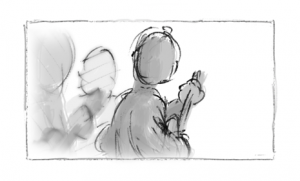
|

|

|
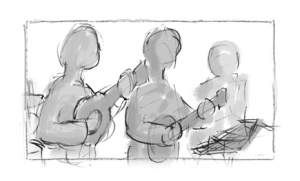
|
For a more involving, more interesting video, you may want a variety of framing – including close-ups of faces, of instruments being played. You may even want to get shots of the audience watching, reacting – and have these in a range of framing from close-up to wide-shots.
What can really push up the cost of a performance-based music video is the place you record your performance. That really depends on you. You maybe really want to record your performance in it’s most raw or basic form: in a lock-up or basement. That’s fine. But you may also want to record somewhere – like a studio – where you can control the look of the music video as much as possible. To save money, you don’t need to book a fully professional studio – but it does help if you can hire some kind of studio. A basic rehearsal studio should have basic lighting, screens, to which you can bring your own equipment. As long as you have access to the right equipment and expertise – then you can film anywhere, especially if you are going to mime to playback.
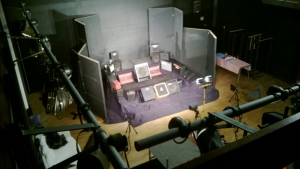
|
This is an example of where your film doesn’t have to reflect on how your video looks. On the left is a shot of how a performance set may be set up in a cheap studio with little equipment. Below, left, is what this set, when framed properly by a camera looks ‘before’ post-production. Then, below right, is a test for what the final footage will look like when colour graded during post-production. |
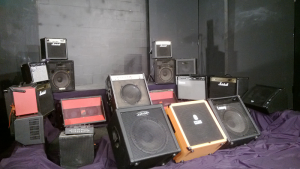
|
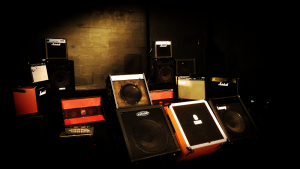
|
| Right is a screenshot from the final performance-based music video for Flying Kangaroo Alliance’s song “Hit The Wall”. This represents the final colour grading of the original footage that looks like the images above, left. As you can see, the look of the original studio can be ‘disguised’ to look like a more expensive, controlled Film/TV studio which would have more equipment available on-site. |

|
|
Flying Kangaroo Alliance “Hit The Wall” (Studio filmed) |
Finally, right, this is the resulting performance music video looks like. Whilst a cheaper studio have been used – the same skills and techniques that would have been used in the more expensive studio are exactly the same that are used in the cheaper studio. |
What can really push up the cost of a music video, or make it more complicated for the performer or band, is the following decision: do you want to be filmed live or to playback? If live – this means you, or the video maker, has to bring in additional equipment and maybe hire additional personnel (engineer, mixer or producer) to handle the music recording and mixing. This has to involve additional costs passed onto the performer or band. However, as is increasingly the case, if the performer or band record and mix their own music, then this makes music video production a lot easier. Depending on how confident the performer or band are, they can either perform to playback or perform being filmed live, using their own equipment to record sound. You just need someone to turn up and film, then edit the resulting footage. However, when filming live, the music video maker has to bring along more than one camera – you need at least four cameras to get good footage for editing. This contrasts to miming – you just need one camera, but be prepared to mime multiple times to playback; getting good footage might require at least 3-4 takes. Live filming with multiple cameras generates more footage quickly (say, 30 minutes could produce 4-6 songs) – but you then have to be prepared to pay for editing for all the songs filmed. Filming to playback may not generate as much footage (30 minutes will produce 4-5 takes of the same song), but the footage produced is focused on producing a single music video: a single music video may not cost that much.
